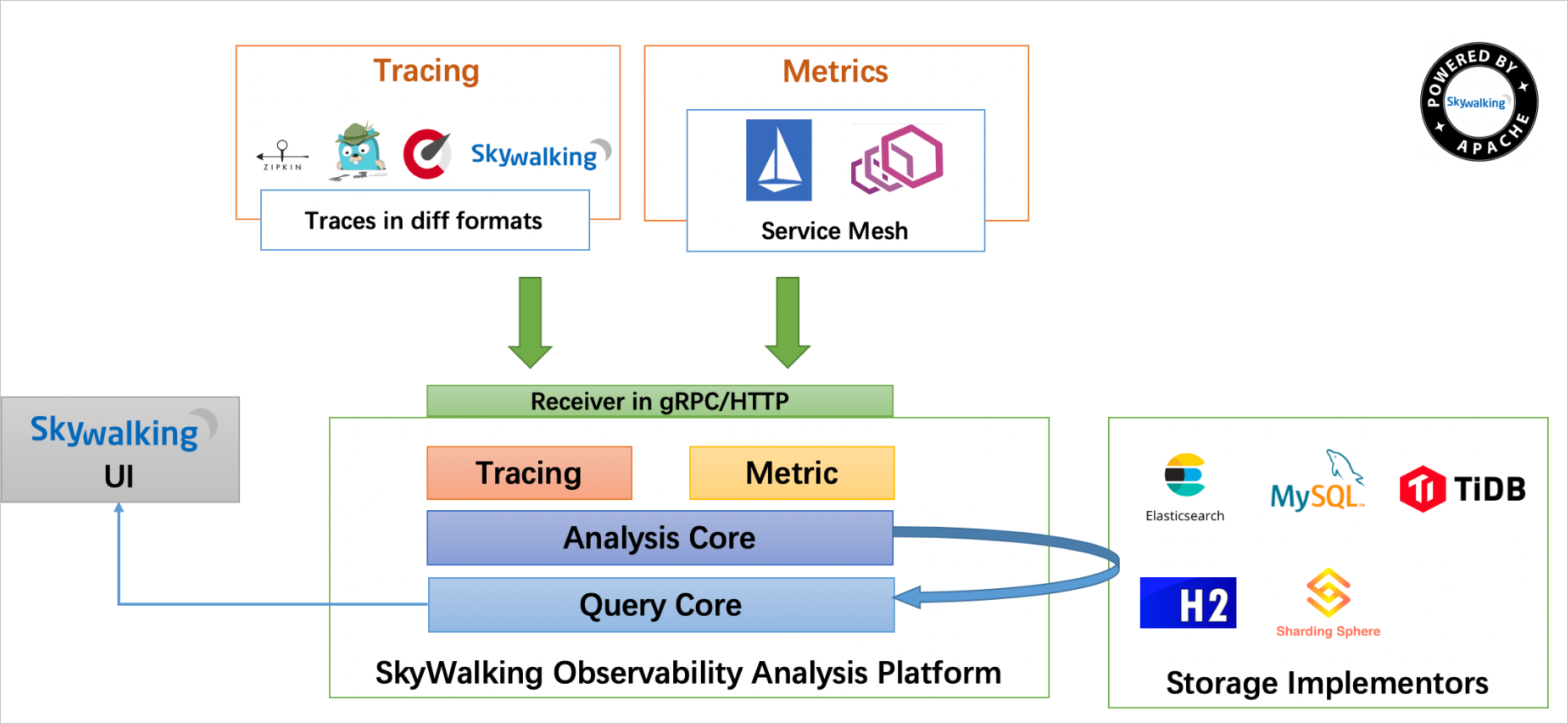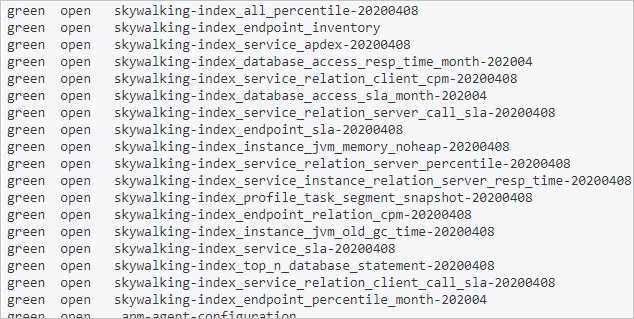SkyWalking is a distributed application performance monitoring (APM) tool and a distributed tracing system. This topic describes how to use SkyWalking to monitor an Alibaba Cloud Elasticsearch V7.4 cluster.
Background information
SkyWalking has the following features:
SkyWalking provides auto instrument agents so that you do not need to modify the application code.
SkyWalking provides manual instrument agents that support OpenTracing SDKs. The manual instrument agents can monitor the components supported by OpenTracing API for Java.
NoteFor more information about the components supported by OpenTracing API for Java, see OpenTracing Registry.
Auto and manual instrument agents can be used at the same time. Manual instrument agents can monitor the components that are not supported by auto instrument agents, and even private components.
SkyWalking is a Java-based backend program for analytics. It provides RESTful APIs and analytics capabilities for agents of other languages.
SkyWalking provides high-performance streaming analytics.
The following figure shows the SkyWalking architecture.
SkyWalking is a platform for storing data analytics and measurement results. These results are submitted to SkyWalking Collector over HTTP or gRPC. SkyWalking Collector analyzes and aggregates data and stores the data in Elasticsearch, H2, MySQL, or TiDB. You can view the analysis results on the SkyWalking UI. SkyWalking collects data in different formats from multiple sources, such as SkyWalking agents in different programming languages, Zipkin v1, Zipkin v2, Istio telemetry, and Envoy.
In this topic, SkyWalking is integrated into Alibaba Cloud Elasticsearch V7.4. You can also use a SkyWalking client to report data to a Java application. For more information, see Use SkyWalking to report Java application data. For more information about the middleware and components supported by SkyWalking, see Apache SkyWalking documentation.
Prerequisites
An Alibaba Cloud Elasticsearch cluster is created. In this topic, an Elasticsearch V7.4.0 cluster is used.
For more information, see Create an Alibaba Cloud Elasticsearch cluster.
A Linux server on which JDK 1.8.0 or later is installed is prepared.
We recommend that you use an Alibaba Cloud Elastic Compute Service (ECS) instance. For more information about how to purchase an ECS instance, see Step 1: Create an ECS instance.
NoteFor more information about how to install a JDK, see Step 3: Install the JDK. If the JDK is not correctly installed and you start SkyWalking to view logs, the error message "Java not found" or "java-xxx: No such file or directory" is reported.
Ports 8080, 10800, 11800, and 12800 on the Linux server are not occupied.
The firewall and Security-Enhanced Linux (SELinux) are disabled for the Linux server.
Procedure
Step 1: Download and install SkyWalking
Download the SkyWalking package to the Linux server.
An Elasticsearch V7.4.0 cluster is used in this topic. Therefore, you must select Binary Distribution for ElasticSearch 7. The following code provides the command that is used to download the package:
wget https://archive.apache.org/dist/skywalking/7.0.0/apache-skywalking-apm-es7-7.0.0.tar.gzRun the following command to decompress the package:
tar -zxvf apache-skywalking-apm-es7-7.0.0.tar.gzRun the following command to view the decompressed files:
ls apache-skywalking-apm-bin-es7/The following result is returned:
total 92 agent bin config LICENSE licenses NOTICE oap-libs README.txt tools webapp
Step 2: Configure SkyWalking to connect to the Elasticsearch cluster
Run the following code to open the application.yml file in the config folder:
cd apache-skywalking-apm-bin-es7/config/ vi application.ymlLocate
storage, change H2 to elasticsearch7, and configure the file based on the following instructions:storage: selector: ${SW_STORAGE:elasticsearch7} elasticsearch7: nameSpace: ${SW_NAMESPACE:"skywalking-index"} clusterNodes: ${SW_STORAGE_ES_CLUSTER_NODES:es-cn-4591kzdzk000i****.public.elasticsearch.aliyuncs.com:9200} protocol: ${SW_STORAGE_ES_HTTP_PROTOCOL:"http"} # trustStorePath: ${SW_SW_STORAGE_ES_SSL_JKS_PATH:"../es_keystore.jks"} # trustStorePass: ${SW_SW_STORAGE_ES_SSL_JKS_PASS:""} enablePackedDownsampling: ${SW_STORAGE_ENABLE_PACKED_DOWNSAMPLING:true} # Hour and Day metrics will be merged into minute index. dayStep: ${SW_STORAGE_DAY_STEP:1} # Represent the number of days in the one minute/hour/day index. user: ${SW_ES_USER:"elastic"} password: ${SW_ES_PASSWORD:"es_password"}NoteSkyWalking stores data in H2 by default. However, H2 does not support persistent data storage. Therefore, you must change H2 to Elasticsearch.
Parameter
Description
selector
The storage selector. For this example, set the value to elasticsearch7.
nameSpace
The namespace. The value of this parameter is used as the prefix for the names of all indexes in the Elasticsearch cluster.
clusterNodes
The endpoint of the Elasticsearch cluster. The Elasticsearch cluster is not in the same virtual private cloud (VPC) as SkyWalking. You must use the public endpoint to access the Elasticsearch cluster. For more information about how to obtain the public endpoint of the Elasticsearch cluster, see View the basic information of a cluster.
user
The username that is used to access the Elasticsearch cluster. The default username is elastic.
password
The password that is used to access the Elasticsearch cluster. The password of the elastic user is specified when you create the Elasticsearch cluster. If you forget the password, you can reset it. For more information about how to reset the password, see Reset the access password for an Elasticsearch cluster.
ImportantSpecify only the username and password. Comment out trustStorePath and trustStorePass. Otherwise, the error message "NoSuchFileException:../es_keystore.jks" is reported.
Optional:Change the IP address or port number for listening.
By default, SkyWalking communicates with Elasticsearch over port 12800 for RESTful API operations and over port 11800 for gRPC API operations. The IP address or port number can be changed in the core part of the application.yml file. In this topic, the default values are used.
core: selector: ${SW_CORE:default} default: # Mixed: Receive agent data, Level 1 aggregate, Level 2 aggregate # Receiver: Receive agent data, Level 1 aggregate # Aggregator: Level 2 aggregate role: ${SW_CORE_ROLE:Mixed} # Mixed/Receiver/Aggregator restHost: ${SW_CORE_REST_HOST:0.0.0.0} restPort: ${SW_CORE_REST_PORT:12800} restContextPath: ${SW_CORE_REST_CONTEXT_PATH:/} gRPCHost: ${SW_CORE_GRPC_HOST:0.0.0.0} gRPCPort: ${SW_CORE_GRPC_PORT:11800}Optional:In the webapp folder, modify the configurations in the webapp.yml file.
Default configurations are used in this topic. You can modify the configurations based on your business requirements.
server: port: 8080 collector: path: /graphql ribbon: ReadTimeout: 10000 # Point to all backend's restHost:restPort, split by , listOfServers: 127.0.0.1:12800
Step 3: Verify the results
Run the following commands to start SkyWalking on the Linux server:
cd ../bin ./startup.shImportantBefore you start SkyWalking, make sure that the Elasticsearch cluster is normally running.
SkyWalking Collector and SkyWalking UI are also started after you run the
startup.shcommand.
If SkyWalking is started, the following result is returned:
SkyWalking OAP started successfully! SkyWalking Web Application started successfully!Enter http://<IP address of the Linux server>:8080/ in the address bar of your browser.
 Note
NoteIf this is the first time you use SkyWalking to connect to Elasticsearch, the startup is slow. This is because SkyWalking needs to create a large number of indexes in Elasticsearch. Before the creation is completed, the accessed page is blank. You can view the logs that are stored in
<SkyWalking installation path>logs/skywalking-oap-server.logto check whether the creation is completed.Log on to the Kibana console of the Elasticsearch cluster. For more information, see Log on to the Kibana console. Then, run the
GET _cat/indices?vcommand to view index data.In the returned results, a large number of indexes whose names start with
skywalking-indexexist.